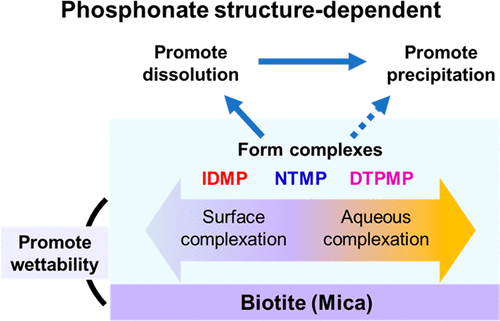当前位置:
X-MOL 学术
›
ACS Earth Space Chem.
›
论文详情
Our official English website, www.x-mol.net, welcomes your
feedback! (Note: you will need to create a separate account there.)
Effects of Phosphonate Structures on Brine–Biotite Interactions under Subsurface Relevant Conditions
ACS Earth and Space Chemistry ( IF 2.9 ) Pub Date : 2018-07-12 00:00:00 , DOI: 10.1021/acsearthspacechem.8b00075 Lijie Zhang 1 , Doyoon Kim 1 , Young-Shin Jun 1
ACS Earth and Space Chemistry ( IF 2.9 ) Pub Date : 2018-07-12 00:00:00 , DOI: 10.1021/acsearthspacechem.8b00075 Lijie Zhang 1 , Doyoon Kim 1 , Young-Shin Jun 1
Affiliation

|
Phosphonates have been widely used as scale inhibitors in energy-related subsurface operations, where their performance is greatly affected by interactions with rocks and minerals. However, information about commonly used phosphonate scale inhibitor–shale interactions is limited. In this study, using Fe-bearing mica (biotite) as a model phyllosilicate mineral, the effects of three common phosphonates, namely, iminodi(methylene)phosphonate (IDMP), nitrilotris(methylene)phosphonate (NTMP), and diethylenetriaminepenta(methylene)phosphonate (DTPMP), were studied at 95 °C and 102 atm CO2. During the experiments (0–70 h), IDMP remained stable, while NTMP and DTPMP were degraded and released phosphate, formate, and new phosphonates with smaller molecular weights. As a result of the differences in complexation capability, IDMP, with the fewest phosphonate functional groups, promoted biotite dissolution mainly through surface complexation and DTPMP, with the most functional groups, promoted biotite dissolution mainly through aqueous complexation. Furthermore, the presence of phosphonates enhanced secondary precipitation of P-, Fe-, and Al-bearing minerals, and their phosphonate structures affected the morphologies, phases, and distributions of secondary precipitates. Owing to phosphonate–biotite interactions (mainly as a result of surface adsorption), the biotite surfaces became much more hydrophilic. This study provides new insights into structure-dependent phosphonate–mineral interactions, and the results have important implications for the safety and efficiency of energy-related subsurface operations.
中文翻译:

地下相关条件下膦酸酯结构对卤水-黑云母相互作用的影响
膦酸酯已被广泛用作与能源有关的地下作业中的阻垢剂,其性能受与岩石和矿物相互作用的极大影响。但是,有关常用的膦酸盐阻垢剂-页岩相互作用的信息是有限的。在这项研究中,使用含铁的云母(黑云母)作为典型的页硅酸盐矿物,三种常见的膦酸酯,即亚氨基二(亚甲基)膦酸酯(IDMP),次氮基三(亚甲基)膦酸酯(NTMP)和二亚乙基三胺五甲基(亚甲基)膦酸酯(DTPMP)在95°C和102 atm CO 2下进行了研究。在实验期间(0-70小时),IDMP保持稳定,而NTMP和DTPMP降解并释放出较小分子量的磷酸盐,甲酸盐和新的膦酸盐。由于络合能力的差异,具有膦酸酯官能团最少的IDMP主要通过表面络合促进了黑云母的溶解,具有最多官能团的DTPMP主要是通过水络合促进了黑云母的溶解。此外,膦酸盐的存在增强了含P,Fe和Al的矿物的二次沉淀,它们的膦酸盐结构影响了二次沉淀的形态,相和分布。由于膦酸酯-黑云母的相互作用(主要是由于表面吸附的结果),黑云母的表面变得更加亲水。
更新日期:2018-07-12
中文翻译:

地下相关条件下膦酸酯结构对卤水-黑云母相互作用的影响
膦酸酯已被广泛用作与能源有关的地下作业中的阻垢剂,其性能受与岩石和矿物相互作用的极大影响。但是,有关常用的膦酸盐阻垢剂-页岩相互作用的信息是有限的。在这项研究中,使用含铁的云母(黑云母)作为典型的页硅酸盐矿物,三种常见的膦酸酯,即亚氨基二(亚甲基)膦酸酯(IDMP),次氮基三(亚甲基)膦酸酯(NTMP)和二亚乙基三胺五甲基(亚甲基)膦酸酯(DTPMP)在95°C和102 atm CO 2下进行了研究。在实验期间(0-70小时),IDMP保持稳定,而NTMP和DTPMP降解并释放出较小分子量的磷酸盐,甲酸盐和新的膦酸盐。由于络合能力的差异,具有膦酸酯官能团最少的IDMP主要通过表面络合促进了黑云母的溶解,具有最多官能团的DTPMP主要是通过水络合促进了黑云母的溶解。此外,膦酸盐的存在增强了含P,Fe和Al的矿物的二次沉淀,它们的膦酸盐结构影响了二次沉淀的形态,相和分布。由于膦酸酯-黑云母的相互作用(主要是由于表面吸附的结果),黑云母的表面变得更加亲水。











































 京公网安备 11010802027423号
京公网安备 11010802027423号